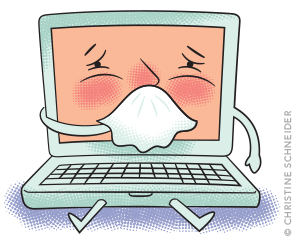
Fam Pract Manag. 2018;25(5):35
ADD A MONITOR TO IMPROVE YOUR PRODUCTIVITY
Back in the days of paper records, it was often easier to tackle complex administrative tasks by laying out multiple documents in front of you. Now that these documents are computerized, you usually can see only one at a time on the screen unless you print them. Our practice has found a way to improve productivity by making a simple change to the work environment. In our exam rooms, we installed widescreen monitors that allow us to see two pages side-by-side. We also analyzed our staff members' work and put two (and sometimes three) widescreen monitors at each of their workstations. Staff members have said they are very satisfied with the result, and their workflow has improved.
FORGET THE “FEEDBACK SANDWICH”
The “feedback sandwich” is a popular approach for giving an employee criticism buffered on each side by a bit of praise. Many years ago, however, a conference speaker I heard advised against its use and referred to it as “a baloney sandwich.” His reasoning was that, when we try to sandwich criticism between small praises, the recipient quickly understands what's going on. Just as two slices of bread are designed primarily to deliver the meat of the sandwich, the praises are there merely to make the criticism more palatable. The recipient often rejects the praise, questioning its sincerity, and may even resent its use. This makes it much less likely that the recipient will understand and respond well to the principally intended criticism.
For me, it takes courage and thoughtful preparation to give someone negative feedback. Unless I am providing a comprehensive performance review that takes a broad look at what the employee is doing well and where there are areas for improvement, I believe that criticism should stand alone. I try to be firm, direct, and preferably provide three specific examples to drive home the point.
Additionally, it's a good idea to monitor performance and provide frequent praise to individuals and groups who are doing their jobs well. That way, if there is need for criticism, the employees are more likely to accept it and take it to heart.
WIPE YOUR COMPUTER CLEAN, LITERALLY

Is your electronic health record making you or your staff sick? Keep your office healthy by regularly cleaning your computer keyboards, keeping a bottle of alcohol gel near your computer to regularly clean your hands, and avoiding the use of porous mousepads that can trap contaminants.
TRACK YOUR TIME TO LOOK FOR EFFICIENCIES
You can't improve what you don't measure, and that applies not only to patient health but also to how you manage your time.
If you feel stressed or overly busy and wonder if you are using your time efficiently, try tracking exactly how you spend each half hour for a month. Record your observations in a spreadsheet program and, at month's end, review and look for patterns or other examples of where you can make changes. For instance, consider the following:
Look for areas where you effectively multitask, such as listening to podcasts or audiobooks while exercising or commuting to work.
Spot repeated instances of “wasted” time, such as mindlessly scrolling through Twitter, Face-book, or other social media right before you go to sleep.
See how much time you spend on activities that stress you out (it probably feels like you're spending more time on these than you actually are), and then make smarter decisions about how to delegate or reshuffle these tasks so you can focus on what you do best.
